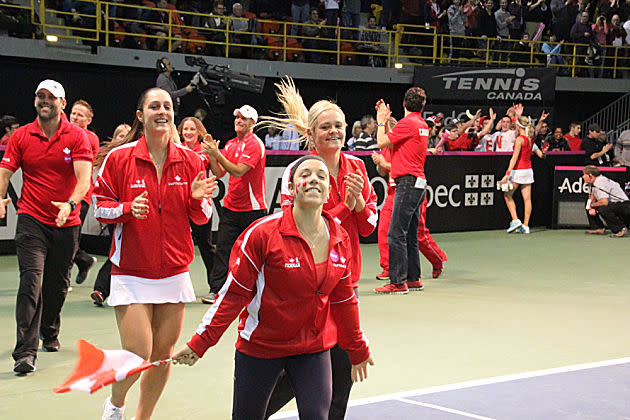Canada will host the Slovak Republic in World Group Fed Cup playoff
Hot on the heels of its impressive win over Serbia in a first-round World Group II tie last weekend in Montreal, the Canadian Fed Cup team will again have home-court advantage as it attempts to get to the prestigious eight-country World Group I in April.
Canada will host the Slovak Republic, after the draw was made at the London offices of the International Tennis Federation Tuesday morning.
The tie will be played April 19-20.
There were four possibilities: the U.S., Russia, Spain and the eventual winner, the only opponent that guaranteed the Canadians would host. Home court for the other three would have been decided by coin toss, since the Fed Cup alternates hosting duties (Canada played away the last time the two teams met) unless there is no history between the two nations.
"They’re tough. They’re tough. But so are we," Fed Cup captain Sylvain Bruneau said Tuesday in a conference call. "On paper, they have five girls in the top 100 – three, basically, in the top 30. But that’s sort of what happens when you get to that level of competition; you start to play countries that have many good players.
"Anything's possible and we’ll go into that tie one match at a time, and thinking we can do this," he added.
The Canadians didn't have especially good luck, or especially bad luck, with the luck of the draw.
The U.S. could very well field Serena and Venus Williams in April, and a tie near the sisters' home in Florida (to help convince them to attend) would be a challenge for the Canadians. Spain would have been highly competitive on an indoor hard court (a pick-em match), far more challenging away, when it would surely be played on slow red clay.
As for the Russians, all would depend on whether they fielded the kids' team that went down to Australia and got schooled last weekend, or a squad with the likes of Maria Sharapova, Maria Kirilenko and other top players.
The two top Slovaks are Dominika Cibulkova, who reached the final of the Australian Open a few weeks ago, and 30-year-old veteran Daniela Hantuchova, currently ranked No. 30 but who has been in the top five in both singles and doubles during her long career.
Is it possible, as with Serbia missing both its top players in Ana Ivanovic and Jelena Jankovic, that the Slovaks might also arrive with a second-tier team?
Unlikely.
"The Slovaks are very patriotic and always play Fed Cup. I don’t think (a challenging commute and change of surface in the middle of the WTA Tour clay-court season) will be a factor," Bruneau said. "The goal is to play with our girls and win against their best lineup. I’m assuming their best will be here; we’ll play on indoor hard and we’ll play well."
Now for the next big question: where will Tennis Canada hold the tie?
The slam-dunk, obvious answer is back in Montreal again, for all the obvious reasons.
Firstly, the Centre Claude-Robillard drew over 6,500 fans for the two days of the tie against Serbia, and that was without any star power whatsoever on the other side of the net. Plus, the two players likely to compete in singles are both Montrealers.
But Tennis Canada has a well-documented philosophy of trying to spread the tennis around the country whenever they can, especially with Montreal and Toronto already hosting major-league Tour events each summer. That was one of the original reasons the Davis Cup squad played in Vancouver, which filled the place for France two years ago. The tie against Spain last February didn't quite pack the same punch, but was still a great success.
Perhaps, as with the success on court, Tennis Canada should follow that Davis Cup "repeat" pattern with the Fed Cup. And a World Group II first-round tie in 2007 against Israel in Kamloops, B.C. should serve as a cautionary tale.
Once you got past Shahar Pe'er, who was then 19, ranked No. 15 in the world and on a serious roll, the dropoff on the Israeli team was huge. Certainly there was hope for the No. 2 singles and the doubles.
But even though the team was made up of Valérie Tetreault, Aleksandra Wozniak, Marie-Ève Pelletier and Stéphanie Dubois (note the number of accents aigus and accents graves on that roster), it was decided to hold this crucial tie before empty seats disguised as fans in a fieldhouse in Kamloops, B.C., some 5,000 kilometres away from a home crowd that most assuredly would have been the fifth girl on the team. They lost the first three rubbers in a 3-2 defeat that ultimately sent them back to the zonal competition.
Bruneau said he understood that philosophy but, for the record, the team thought the conditions last weekend were "perfect."
One interesting option, should Tennis Canada choose Montreal, would be the Maurice-Richard Arena.
From what we can see, it doesn't look booked. It's a smaller hockey arena-type venue, seating just under 5,000 (so slightly larger than the setup at Centre Claude-Robillard). But it has all that permanent seating at a steeper angle already in place – a marked upgrade from the silver bleachers and folding chairs fans had to sit on last weekend.
It's also right on the métro line. Maurice-Richard wasn't in play last weekend, because the Scottie's curling championships were going on all week.
That will be just one of the many decisions the Canadians will have to make before the Slovaks hit passport control in April.

 Yahoo Sports
Yahoo Sports 



